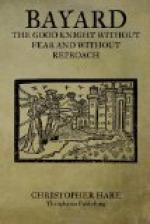The time fixed was only eight days off, but all the same about forty or fifty men-at-arms gave in their names. Fortunately, before the expected day, that gentle knight, the Captain Louis d’Ars, arrived, and he was much delighted to have come in time for this entertainment. When Bayard heard of his captain’s arrival he went to pay his respects to him at once, and was most warmly welcomed, for the boy’s fame had gone before him. To make the festival more complete, his friend Bellabre also appeared, having been delayed by waiting for two splendid horses which he expected from Spain. At length the eventful day arrived, and the gentlemen who wished to take part in the tournament were divided into two equal ranks, there being twenty-three on one side and twenty-three on the other. The judges chosen were the Captain Louis d’Ars and the lord of St. Quentin, captain of the Scotch company.
At this point it will be interesting to give a full account of the details needful for a tournament of this period, the close of the fifteenth century. These tournaments were first started as training-schools for the practice of arms, and were later tempered by the rules of chivalry. Jousts were single combats, often a succession of them, for a prize or trial of skill, while the tourney was troop against troop. These warlike games were very popular in France especially, but very strict rules had to be made to prevent the “joust of peace” becoming the deadly “joust a l’outrance” (to the death).
The “lists,” or tournament grounds, were in Bayard’s time usually of a square shape rather longer than broad, and were surrounded by palisades, often adorned with tapestry and heraldic devices. The marshals of the lists took note of all that happened and enforced the rules of chivalry. Varlets were in attendance to help the esquires in looking after their masters, and helping them up, with their heavy armour, if unhorsed.
It was common to hold a “passage of arms” for three days: two for the contest on horseback, first with lances, second with swords and maces; while on the third day, on foot, pole-axes were used. A specially heavy kind of armour was worn, sometimes nearly 200 lbs. in weight, so that a knight once unhorsed lay on the ground absolutely helpless, and could not rise without help. This armour was made still stronger by “reinforcing armour”—pieces screwed on over the left side, chiefly, which received most blows—making a double defence for the head, chest, and left shoulder. “Pauldrons” or shoulder-guards buckled on, that on the right arm being smaller to leave freedom for using the lance. Then we have brassards or arm-guards; the rere-brace for the upper arm, the vam-brace for the lower, and the elbow-piece called a “coudiere.”




